Biology:List of honey plants
From HandWiki
Short description: none
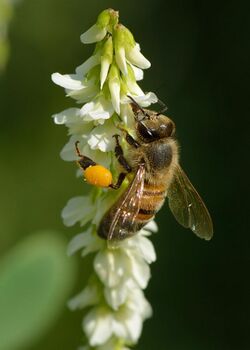




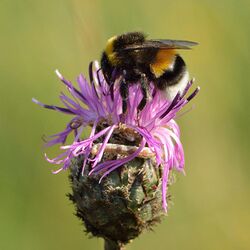



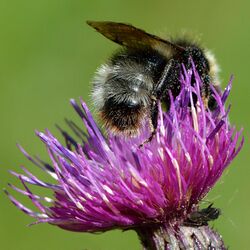

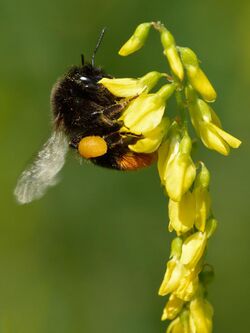



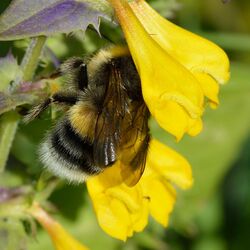







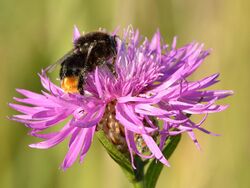
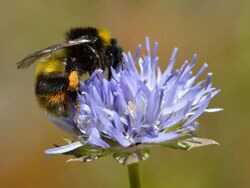






Honeybees usually collect nectar, pollen, or both from the following species of plants, which are called honey plants, for making honey.
Acanthaceae (Acanthus family)
- Avicennia nitida Jacq. or Avicennia germinans (Black mangrove)
Aceraceae (Sapindaceae) (Maple family)
- Acer rubrum L. (Red maple)
- Acer saccharinum L. (Sugar maple)
- Acer spicatum Lam. (Mountain maple)
- Acer pseudoplatanus L. (Sycamore maple)
Agavaceae (Agave family)
- Agave sisalana Perrine ex Engelm. (Sisal)
- Alstroemeria cunea Vell.
Amaranthaceae (Amaranth family)
- Alternanthera brasiliana Kuntze
- Alternanthera dentata (Moench) Stuchlik ex R.E.Fries
- Alternanthera polygonoides R.Br. ex Sweet
- Froelichia humboldtiana Seub.
- Froelichia lanata Moench
- Gomphrena canescens R.Br.
- Gomphrena demissa Mart.
- Gomphrena gardneri Moq.
Amaryllidaceae (Amaryllis family)
- Anacardium occidentale L.
- Anacardium humile A.St.-Hil.
- Astronium fraxinifolium Schott
- Lithraea molleoides Engl.
- Mangifera indica L.
- Myracrodruon urundeuva M.Allemão
- Schinus molle L.
- Schinus terebinthifolius Raddi
- Schinopsis brasiliensis Engl.
- Spondias lutea L.
- Spondias mombin L.
- Spondias tuberosa Arruda
- Tapirira guianensis Aubl.
- Tapirira marchandii Engl.
Apiaceae (Parsley and carrot family)
Apocynaceae (Dogbane family)
All the plants of this family are found in the tropics and subtropics.
- Aspidosperma cylindrocarpon Müll.Arg.
- Aspidosperma dasycarpon A.DC.
- Aspidosperma macrocarpon Mart.
- Aspidosperma parvifolium A.DC.
- Aspidosperma polyneuron A.DC.
- Aspidosperma pruinosum Markgr.
- Aspidosperma pyrifolium Mart., syn. Aspidosperma populifolium A.DC.
- Hancornia speciosa Gomes
- Peschiera affinis Miers
- Rhodocalyx rotundifolia Müll.Arg.
- Tabernaemontana fuchsiaefolia A.DC.
Aquifoliaceae (Holly family)
- Ilex decidua Walter
- Ilex glabra A.Gray
- Ilex opaca Aiton
- Ilex theezans Mart.
- Ilex verticillata A.Gray
Araliaceae (Aralia and ivy family)
- Didymopanax macrocarpum Seem.
- Didymopanax vinosum Marchal
Arecaceae (Palm family)
- Acrocomia aculeata Lodd. ex Mart.
- Attalea speciosa Mart.
- Roystonea elata (Bartr.) F.Harper
- Sabal palmetto Lodd. ex Schult.f.
- Syagrus romanzoffiana (Cham.) Glassman (= Cocos romanzoffiana Cham., or Arecastrum romanzoffianum (Cham.) Becc.).
- Trithrinax campestris (Burmeist.) Drude & Griseb.
Asteraceae (Aster, daisy, sunflower family)
- Ambrosia polystachya DC.
- Baccharis dracunculifolia DC.
- Baccharis genistelloides Pers.
- Baccharis gracilis DC.
- Baccharis halimifolia L.
- Baccharis ligustrina DC.
- Baccharis platypoda DC.
- Baccharis punctulata DC.
- Baccharis serrula Sch.Bip.
- Baccharis sessifolia L.
- Baccharis tridentata Vahl
- Bidens cernua L.
- Bidens pilosa L.
- Cichorium intybus L.
- Cirsium arvense (L.) Scop. (= Carduus arvensis, or Cirsium incanum)
- Cirsium vulgare (Savi) Ten. (= Carduus vulgaris, Carduus lanceolatus, or Cirsium lanceolatum)
- Centaurea biebersteinii (Jaub. et Spach) Walp.
- Centratherum punctatum Cass.
- Cosmos sulphureus Cav.
- Echinops sphaerocephalus L.
- Eremanthus sphaerocephalus Baker
- Eupatorium itatiayense Hieron.
- Eupatorium maculatum L.
- Eupatorium maximiliani Schrad. ex DC.
- Eupatorium purpureum L.
- Eupatorium squalidum DC.
- Helianthus annuus L. (Sunflower)
- Helianthus tuberosus L. (Jerusalem artichoke)
- Karelinia caspia (Pall.) Less.
- Liatris spicata Willd.
- Mikania cordifolia Willd.
- Mikania hirsutissima DC.
- Mikania microphylla Sch.Bip. ex Baker
- Mikania speciosa DC.
- Mikania sessilifolia DC.
- Moquinia polymorpha DC.
- Oligoneuron rigidum Small (= Solidago rigida L.)
- Piptocarpha notata Baker
- Piptocarpha rotundifolia Baker
- Rudbeckia spp. L.
- Sonchus arvensis L.
- Senecio brasiliensis Less.
- Solidago chilensis Meyen
- Symphyotrichum novae-angliae (L.) G.L.Nesom
- Taraxacum officinale Weber
- Trichogonia salviaefolia Gardner
- Trixis antimenorrhoea Mart. ex Baker
- Verbesina alternifolia Britton ex Kearney
- Vernonia apiculata Mart. ex DC.
- Vernonia argyrophylla Less.
- Vernonia diffusa Less.
- Vernonia herbacea Rusby
- Vernonia lacunosa Mart. ex DC.
- Vernonia linearis D.Don ex Hook. et Arn.
- Vernonia patens Kunth
- Vernonia polyanthes Less.
- Vernonia scorpioides Pers.
- Vernonia virgata Gagnep.
- Zinnia multiflora L.
Bignoniaceae (Trumpet creeper family)
All the plants of this family are found mostly in the tropics or subtropics.
- Campsis radicans Seem. (= Bignonia radicans, or Tecoma radicans)
- Catalpa bignonioides Walter
- Catalpa speciosa Warder ex Engelm.
- Cybistax antisyphilitica (Mart.) Mart.
- Handroanthus albus
- Handroanthus impetiginosus
- Jacaranda brasiliana Pers.
- Jacaranda caroba Hort. ex Lem.
- Jacaranda decurrens Cham.
- Jacaranda paucifoliolata Mart. ex DC.
- Memora glaberrima K.Schum.
- Memora nodosa Miers
- Podranea ricasoliana (Tanfani) T. Sprague
- Pyrostegia ignea Presl
- Pyrostegia venusta Miers
- Tabebuia aurea
- Tabebuia chrysotricha
- Tabebuia heptaphylla (Vell.) Toledo
- Tabebuia ochracea
- Tabebuia rosea (Bertol.) DC.
- Tabebuia roseo-alba
- Tabebuia serratifolia
- Tabebuia vellosoi Toledo
- Zeyheria digitalis (Vell.) Hoehne et Kuhlm.
Bixaceae (Achiote family)
Bombacaceae (see also Malva family)
- Bombax campestre K.Schum.
- Bombax tomentosum A.Juss.
- Chorisia speciosa A.St.-Hil.
- Eriotheca gracilipes (K.Schum.) A.Robyns
- Pseudobombax grandiflorum (Cav.) A.Robyns
Boraginaceae (Borage or Forget-me-not family)
- Anchusa strigosa Banks & Sol.[1]
- Auxemma glazioviana Taub.
- Auxemma oncocalyx Taub.
- Borago officinalis L.[1]
- Cerinthe major L.
- Cordi alliodora Cham.
- Cordia campestris Warm.
- Cordia corymbosa G.Don
- Cordia hypoleuca DC.
- Cordia insignis Cham.
- Cordia leucocephala Moric.
- Cordia nodosa Lam.
- Cordia trichotoma (Vell.) Steud.
- Cordia verbenacea DC.
- Echium plantagineum L.
- Echium simplex DC.
- Echium virescens DC.
- Echium wildpretii H.Pearson ex Hook.f.
- Symphytum brachycalyx Boiss.[1]
- Phacelia tanacetifolia Benth.
- Patagonula americana L.
Brassicaceae (Mustard family or cabbage family)
- Brassica campestris L.
- Brassica juncea Coss.
- Brassica napus L.
- Brassica oleracea L. var. botrytis L.
- Brassica oleracea L. var. capitata
- Brassica oleracea L. var. gemnifera
- Brassica oleracea L. var. gongylodes
- Eruca sativa Mill.
- Lobularia maritima (L.) Desv.
- Sinapis alba L.
- Apuleia molaris Spruce ex Benth.
- Bauhinia forficata Link
- Cassia ferruginea (Schrad.) DC.
- Cassia grandis L.f.
- Caesalpinia echinata Lam.
- Caesalpinia ferrea Mart.
- Caesalpinia peltophoroides Benth.
- Caesalpinia pyramidalis Tul.
- Caesalpinia microphylla Mart.
- Copaifera langsdorffii Desf.
- Copaifera oblongifolia Mart. ex Hayne
- Delonix regia Raf.
- Hymenaea courbaril var. stilbocarpa (Hayne) Y.T.Lee et Langenh.
- Schizolobium parahyba (Vell.) Blake
- Schotia brachypetala Sond.
- Sclerolobium aureum Baill.
- Sclerolobium paniculatum Vogel
- Senna martiana (Benth.) H.S.Irwin et Barneby
- Senna multijuga (Rich.) H.S.Irwin et Barneby
- Senna speciosa Roxb.
- Senna splendida (Vogel) H.S.Irwin et Barneby
Cannabaceae (Hemp Family)
Capparaceae (Caper family)
Caprifoliaceae (Honeysuckle family)
- Lonicera japonica Thunb. ex A.Murray bis
All the plants of this family are found only in the neotropics.
- Caryoca brasiliense Cambess.
Caryophyllaceae (Carnation family)
Celastraceae (staff vine or bittersweet family)
- Maytenus boaria Molina
found in tropics or sub-tropics
- Couepia grandiflora Benth.
- Parinari obtusifolia Hook.f.
- Hirtella glandulosa Spreng.
- Hirtella martiana Hook.f.
- Clethra scabra Pers.
- Kielmeyera coriacea Mart. & Zucc.
- Cochlospermum regium Pilg.
- Commelina agraria Kunth
- Tradescantia virginica L.
Convolvulaceae (Bindweed or morning glory family)
- Ipomoea purpurea Roth
- Ipomoea batatoides Benth.
- Jacquemontia blanchetii Moric.
- Rivea corymbosa (L.) Hallier f.
Cucurbitaceae (Melon, cucumber, calabash, squash family)
- Cayaponia ficifolia Cogn.
- Citrullus vulgaris Schrad. C.lanatus Nakai
- Cucumis melo L.
- Cucumis sativus L.
- Cucurbita maxima Duchesne
- Cucurbita pepo L.
- Luffa cylindrica M.Roem.
- Eucryphia cordifolia Cav.
- Eucryphia lucida (Labill.) Baill.
- Lamonia speciosa (Cambess.) L.B.Sm.
- Weinmannia trichosperma Ruiz & Pav.
- Curatella americana L.
- Davilla rugosa Poir.
- Diospyros kaki L.f.
- Crinodendron patagua Mol.
Ericaceae (Blueberry, Heather family)
- Arctostaphylos uva-ursi (L.) Spreng.
- Calluna vulgaris (L.) Hull
- Erica cinerea L.
- Vaccinium angustifolium Aiton
- Vaccinium corymbosum L.
- Oxydendrum arboreum (L.) DC.
Erythroxylaceae (Coca family)
- Erythroxylum campestre A.St.-Hil.
- Erythroxylum suberosum A.St.-Hil.
- Erythroxylum tortuosum Mart.
- Escallonia montevidensis DC.
Euphorbiaceae (Spurge family)
- Alchornea iricurana Casar.
- Alchornea triplinervia (Spreng.) Müll.Arg.
- Aleurites fordii Hemsl.
- Croton floribundus Spreng.
- Croton macrobothrys Baill.
- Croton salutaris Casar.
- Dalechampia humilis Müll.Arg.
- Euphorbia mellifera Seub.
- Euphorbia pulcherrima Willd. ex Klotzsch
- Julocroton triqueter Baill.
- Phyllanthus acidus (L.) Skeels
- Ricinus communis L.
- Sapium sebiferum (L.) Roxb.
Faboideae (Legume family)
- Andira inermis (Wright) DC.
- Amburana cearensis (= Torresea cearensis M.Allemão) (M.Allemão) A.C.Smith
- Centrolobium robustum Mart. ex Benth.
- Gliricidia sepium (Jacq.) Steud
- Geoffraea spinosa Jacq.
- Machaerium acutifolium Vogel
- Machaerium scleroxylon Tul.
- Medicago sativa L.
- Melilotus alba Medik.
- Melilotus officinalis Lam.
- Myrocarpus frondosus M.Allemão
- Sweetia fruticosa var. fruticosa Spreng. (= Ferreirea spectabilis M.Allemão)
- Trifolium pratense L.
- Trifolium repens L.
Salicaceae
- Crocus vernus (L.) Hill
Lamiaceae (Mint family)
- Agastache foeniculum Kuntze
- Agastache nepetoides
- Eriope crassipes Benth.
- Hyptis brevipes Poit.
- Hyptis cana Pohl ex Benth.
- Hyptis nudicaulis Benth.
- Hyptis suaveolens Poit.
- Hyptis umbrosa Salzm. ex Benth.
- Lavandula spp. L.
- Leonurus cardiaca L.
- Leonurus sibiricus L.
- Monarda didyma L.
- Monarda fistulosa L.
- Nepeta cataria L.
- Nepeta × faassenii
- Nepeta mussinii Spreng. ex Henckel
- Nepeta siberica (= Nepeta macrantha, Dracocephalum sibiricum)
- Pycnanthemum tenuifolium Schrad.
- Pycnanthemum verticillatum Pursh var. pilosum (Nutt.) T.S.Cooperrider
- Pycnanthemum virginianum Trel. ex Branner et Coville
- Salvia splendens Ker Gawl.
- Satureja thymbra L.[1]
- Stachys byzantina K.Koch
- Thymbra spicata L.[1]
- Thymus capitatus (L.) Hoffmanns. & Link[2]
- Thymus serpyllum L.
- Vitex sellowiana Cham.
Lauraceae (Laurel family)
- Beilschmiedia berteroana (Gay) Kosterm.
- Nectandra cuspidata Nees et Mart. ex Nees
- Nectandra rigida Nees
- Persea americana Mill.
- Persea gratissima Gaertn.
- Ocotea kuhlmanni Vattimo
- Ocotea pretiosa Mez
- Cariniana legalis Kuntze
- Cariniana estrellensis Kuntze
Liliaceae (Lily family)
- Smilax medica Schltdl. et Cham.
- Smilax officinalis Griseb.
- Cuphea carthaginensis Macbride
- Cuphea ingrata Cham. et Schltdl.
- Cuphea linarioides Cham. et Schltdl.
- Cuphea mesostemon Koehne
- Heimi myrtifolia Hort.Berol. ex Cham. et Schltdl.
- Lafoensia pacari A.St.-Hil.
- Lagerstroemia indica L.
Magnoliaceae (Magnolia and tulip tree family)
All the plants of this family are found in the neotropics.
- Banisteriopsis campestris (A.Juss.) Little
- Banisteriopsis clausseniana (A.Juss.) W.R.Anderson et B.Gates
- Banisteriopsis gardneriana (A.Juss.) W.R.Anderson et B.Gates
- Banisteriopsis pubipetala (Juss) Cuatrec.
- Byrsonima crassa Nied.
- Byrsonima crassifolia L.Rich
- Byrsonima coccolobifolia Kunth
- Byrsonima intermedia A.Juss.
- Byrsonima subterranea Brade et Markgr.
- Byrsonima verbascifolia Rich. ex Juss.
- Heteropteris aceroides Griseb.
Malvaceae (Malva family)
- Dombeya rotundifolia (Hochst.) Planch.
- Pavonia malvaviscoides A.St.-Hil.
- Pavonia rosa-campestris A.St.-Hil.
- Pavonia speciosa Kunth
Meliaceae (Mahogany family)
- Cedrela fissilis Vell.
- Cedrela odorata Vell.
- Acacia farnesiana (L.) Willd.
- Acacia paniculata Willd.
- Acacia plumosa Mart. ex Colla
- Albizia polyantha (Spreng.f.) G.P.Lewis (= Pithecelobium multiflorum (Kunth) Benth.)
- Albizia polycephala (Benth.) Killip ex Record (= Pithecellobium polycephalum Benth.)
- Anadenanthera colubrina (Vell.) Brenan var. cebil (Griseb.) Altschul (= Anadenanthera macrocarpa (Benth.) Brean)
- Anadenanthera contorta (Benth.) Brenan
- Anadenanthera falcata Speg. (= Piptadenia falcata Benth.)
- Anadenanthera peregrina Speg.
- Calliandra dysantha Benth.
- Enterolobium contortisiliquum (Vell.) Morong
- Enterolobium gummiferum (Mart.) Macbride
- Inga affinis DC.
- Inga edulis Mart.
- Inga marginata Willd.
- Inga paterno Harms
- Inga sessilis Mart.
- Leucaena glauca Benth.
- Mimosa acutistipula Benth.
- Mimosa bimucronata Kuntze
- Mimosa caesalpiniaefolia Benth.
- Mimosa laticifera Rizzini et N.F.Mattos
- Mimosa multipinna Benth.
- Piptadenia gonoacantha Benth.
- Piptadenia paniculata Benth.
- Pithecolobium avaremotemo Mart.
- Pithecolobium diversifolium Benth.
- Pithecolobium dumosum Benth. (= Chloroleucon dumosum (Benth.) G.P.Lewis)
- Pithecellobium inopinatum (Harms) Ducke
- Stryphnodendron adstringens (Mart.) Coville
- Stryphnodendron obovatum Benth.
- Rapanea ferruginea Mez (= Caballeria ferruginea Ruiz et Pav.)
- Rapanea lancifolia Mez
- Rapanea umbellata Mez
Myrtaceae (Myrtle family)
- Amomyrtus meli (Phil.) D.Legrand & Kausel
- Campomanesia adamantium Blume
- Campomanesia crenata O.Berg
- Campomanesia guazumaefolia Blume
- Campomanesia pubescens O.Berg
- Campomanesia xanthocarpa O.Berg
- Corymbia citriodora (Hook.) K.D. Hill & L.A. Johnson
- Genus Eucalyptus L'Her., especially the following species:
- Eucalyptus alba;
- Eucalyptus camaldulensis;
- Eucalyptus citriodora;
- Eucalyptus corymbosa;
- Eucalyptus drepanophylla;
- Eucalyptus globulus;
- Eucalyptus maculata;
- Eucalyptus melliodora;
- Eucalyptus microcorys;
- Eucalyptus oleosa;
- Eucalyptus paniculata;
- Eucalyptus citriodora;
- Eucalyptus redunca;
- Eucalyptus scabra;
- Eucalyptus tereticornis;
- Eucalyptus triantha;
- Eucalyptus wandoo.
- Eugenia brasiliensis Lam.
- Eugenia caryophyllata Thunb. (= Syzygium aromaticum (L.) Merr. et Perry)
- Eugenia convexinervia D.Legrand
- Eugenia dombeyana DC.
- Eugenia dysenterica DC.
- Eugenia hyemalis Cambess.
- Eugenia multicostata D.Legrand
- Eugenia pyriformis Cambess.
- Eugenia uniflora L.
- Myrceugenia euosma (O.Berg) D.Legrand
- Myrcia rostrata DC.
- Myrciaria cauliflora (Mart.) O.Berg
- Myrciaria glomerata O.Berg
- Leptospermum scoparium J.R.Forst. & G.Forst.
- Luma apiculata (DC.) Burret
- Metrosideros umbellata Cav.
- Psidium araca Raddi
- Psidium cinereum Mart. ex DC.
- Psidium firmum O.Berg
- Psidium guajava L.
- Ouratea castaneifolia (DC.) Engl.
- Ouratea floribunda Engl.
- Ouratea spectabilis Engl.
- Ouratea nana Engl.
Oleaceae (Olive family)
- Olea europaea L.
- Ligustrum imatophyllum
- Ligustrum japonicum Thunb.
- Antigonon leptopus — Hook. et Arn.
- Eriogonum fasciculatum— Benth.
- Eriogonum giganteum — S.Wats.
- Fagopyrum esculentum (buckwheat) — Moench
- Fagopyrum sagittatum — Gilib.
- Polygonum punctatum — Raf.
- Reynoutria japonica (syn. Polygonum cuspidatum) – Japanese knotweed
Passifloraceae (Passion flower family)
- Passiflora haematostigma Mast.
- Passiflora pohlii Mast.
Poaceae(Gramineae)
- Banksia integrifolia L.f.
- Banksia sessilis (Knight) A.R.Mast & K.R.Thiele
- Gevuina (Molina) Gaertn.
- Grevillea banksii R.Br.
- Grevillea robusta A.Cunn. ex R.Br.
- Grevillea rosmarinifolia A.Cunn.
- Grevillea thelemanniana Hueg.
- Protea repens
- Protea cynaroides
- Roupala brasiliensis Klotzsch
- Roupala cataractarum Sleumer
- Roupala heterophylla hl
- Roupala montana Willd.
- Roupala tomentosa Pohl
- Knightia excelsa R. Br.
Rhamnaceae (Buckthorn family)
Rosaceae (Rose family)
- Eriobotrya japonica (Thunb.) Lindl.
- Prunus amygdalus L.
- Prunus armeniaca L.
- Prunus avium (L.) L.
- Prunus domestica L.
- Prunus persica (L.) Batsch
- Pyrus communis L.
- Alibertia sessilis K.Schum.
- Borreria verticillata G.Mey.
- Borreria latifolia K.Schum.
- Borreria suaveolens G.Mey.
- Borreria verbenoides Cham. et Schltdl.
- Cephalanthus occidentalis L.
- Chinchona spp. L.
- Coffea arabica L.
- Coutarea hexandra (Jacq.) K.Schum.
- Citrus aurantifolia Swingle
- Citrus limonum Risso
- Citrus medica L.
- Citrus reticulata Blanco
- Citrus sinensis (L.) Osbeck
- Murraya paniculata (L.) Jack
Salicaceae (Willow and poplar family)
- Salix amygdaloides Andersson
- Salix bebbiana Sarg.
- Salix caprea L.
- Salix discolor Muhl.
- Salix nigra Marshall
Sapindaceae (Soapberry family)
- Cupania oblongifolia Mart.
- Cupania vernalis Cambess.
- Dodonaea viscosa Mart.
- Magonia pubescens A.St.-Hil.
- Matayba guianensis Aubl.
- Serjania erecta Radlk.
- Serjania grandifolia Paul Antoine Sagot (fr) ex Radlk.
- Buddleja brasiliensis Jacq.
- Buddleja davidii
- Scrophularia californica Cham. et Schltdl.
Solanaceae (Tomato, potato, egg plant family)
- Acnistus arborescens Schltdl.
- Acnistus cauliflorus Schott
- Solanum paniculatum L.
- Guazuma ulmifolia Lam.
- Sterculia striata A.St.-Hil. et Naudin
- Dombeya natalensis Sond.
- Dombeya wallichii Benth. et Hook.f.
- Waltheria tomentosa (J.R. et G.Forst.) H.St.John
Tiliaceae (Basswood, linden family)
- Luehea candicans Mart.
- Luehea divaricata Mart.
- Luehea grandiflora Mart.
- Luehea paniculata Mart.
- Luehea rufescens A.St.-Hil.
- Triumfetta semitriloba Jacq.
Urticaceae (Nettle family)
- Boehmeria caudata Sw.
Verbenaceae (Verbena family)
- Aegiphila lhotskiana Cham.
- Aegiphila tomentosa Cham.
- Aloysia virgata (Ruiz et Pav.) Juss. (= Lippia urticoides (Cham.) Steud.)
- Lantana camara L.
- Lantana lilacina Desf.
- Lantana trifolia L.
- Lippia alba N.E.Br. ex Britton et P.Wilson
- Lippia candicans Hayek
- Petrea subserrata Cham.
- Petrea volubilis L.
- Zapania citriodora Lam. (= Lippia citriodora (Lam.) Kunth)
All the plants of this family are found in the neotropics.
- Qualea grandifolia Mart.
- Qualea multiflora Mart.
- Qualea parviflora Mart.
See also
- Toxic honey plants, whose nectar results in toxic honey
- Forage (honeybee)
- Honeydew source
- Nectar source
- Northern American nectar sources for honey bees
- Pollen source
- Melliferous flower
- Regional honeys
References
- ↑ 1.0 1.1 1.2 1.3 1.4 Work and Customs in Palestine. I/2. Ramallah: Dar Al Nasher. 2013. p. 563. ISBN 9789950385-01-6. OCLC 1040774903. https://www.amazon.com/Customs-Palestine-Translation-Gustaf-2013-08-02/dp/B01K3MCDFE.
- ↑ Work and Customs in Palestine. I/2. Ramallah: Dar Al Nasher. 2013. pp. 563–564. ISBN 9789950385-01-6. OCLC 1040774903. https://www.amazon.com/Customs-Palestine-Translation-Gustaf-2013-08-02/dp/B01K3MCDFE.
- ↑ "Frangula alnus". https://www.fs.usda.gov/database/feis/plants/shrub/fraaln/all.html.
- ↑ "Plants of Special Value to Honey Bees". https://www.wildflower.org/collections/printable.php?collection=xerces_honey.
- ↑ "Woollyleaf Ceanothus, Ceanothus tomentosus". https://calscape.org/Ceanothus-tomentosus-(Woollyleaf-Ceanothus).
- (in Portuguese) BRANDÃO, M.; FERREIRA, P. B. D. (1991). Flora Apícola do Cerrado.(Honey flora of Cerrado) Informe Agropecuário 15 (168): 5–7.
- (in Portuguese) CÂNDIDO, F. A. (1992) As árvores e a apicultura. (Trees and beekeeping.) UFV
- Michigan bee plants
- (in Portuguese) WIESE, H. (1993) Nova apicultura. (New beekeeping.) Livraria e Editora Agropecuária
External links
 |

